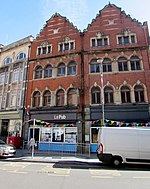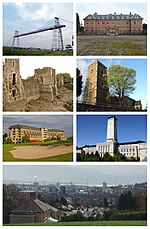Newport (Welsh: Casnewydd; [kasˈnɛwɨð]) is a city and county borough in Wales, situated on the River Usk close to its confluence with the Severn Estuary, 12 mi (19 km) northeast of Cardiff. With a population of 145,700 at the 2011 census, Newport is the third-largest principal authority with city status in Wales, and seventh most populous overall. Newport became a unitary authority in 1996 and forms part of the Cardiff-Newport metropolitan area, also known as the Cardiff Capital Region. Newport was the site of the last large-scale armed insurrection in Great Britain, the Newport Rising of 1839.
The population grew considerably between the 2011 and the 2021 census, rising to 159,587, the largest growth of any unitary authority in Wales.
Newport has been a port since medieval times when the first Newport Castle was built by the Normans. The town outgrew the earlier Roman town of Caerleon, immediately upstream and now part of the city. Newport gained its first charter in 1314. It grew significantly in the 19th century when its port became the focus of coal exports from the eastern South Wales Valleys. Newport was the largest coal exporter in Wales until the rise of Cardiff in the mid-1800s.
In the 20th century, the docks declined in importance, but Newport remained an important centre for manufacturing and engineering. Latterly its economy has been bolstered as part of the M4 corridor high-technology cluster. It was granted city status in 2002. The Celtic Manor Resort in Newport hosted the Ryder Cup in 2010 and was the venue for the 2014 NATO summit. The city contains extensive rural areas surrounding the built-up core. Its villages are of considerable archaeological importance. Newport Cathedral is the seat of the Anglican Bishop of Monmouth and is the cathedral of the Diocese of Monmouth.









